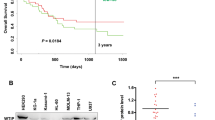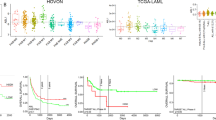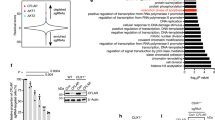Abstract
AML1-ETO, a leukemia-associated fusion protein generated by the frequently occurred chromosome translocation t(8;21) in acute myeloid leukemia, was shown to exert dichotomous functions in leukemic cells, that is, growth arrest versus differentiation block. By the analysis of oligonucleotide microarray, AML1-ETO was shown to modulate the expressions of an impressive array of pro- and anti-apoptotic genes. Here, we investigate potential effects of the ecdysone inducible AML1-ETO expression on apoptosis of leukemic U937 cell line. We show that AML1-ETO significantly stabilizes death receptor Fas protein and increases proapoptotic Bak in addition to reducing Bcl-2 expression. Accordingly, inducible AML1-ETO expression is followed by apoptosis to a lower degree. Especially, AML1-ETO endows leukemic cells with the susceptibility to anti-Fas agonist antibody, ultraviolet light and camptothecin analog NSC606985-induced apoptosis with increased activation of caspase-3/8. Considering that apoptosis-enhancing effect of AML1-ETO would not be favorable to the leukemogenesis harboring the t(8;21) translocation, it must be overcome to fulfill their leukemogenic potential. Complementary to this prediction is that two AML1-ETO-carrying leukemic cells, Kasumi-1 and SKNO-1, present similar sensitivity to apoptosis induction with AML1-ETO-negative leukemic cells. Therefore, genetic and/or epigenetic screenings of apoptosis-related genes modulated by AML1-ETO deserve to be explored for understanding the mechanisms of AML1-ETO-induced leukemogenesis.
This is a preview of subscription content, access via your institution
Access options
Subscribe to this journal
Receive 12 print issues and online access
$259.00 per year
only $21.58 per issue
Buy this article
- Purchase on Springer Link
- Instant access to full article PDF
Prices may be subject to local taxes which are calculated during checkout





Similar content being viewed by others
References
Erickson P, Gao J, Chang KS, Look T, Whisenant E, Raimondi S et al. Identification of breakpoints in t(8;21) acute myelogenous leukemia and isolation of a fusion transcript, AML1-ETO, with similarity to Drosophila segmentation gene, runt. Blood 1992; 80: 1825–1831.
Ito Y . Oncogenic potential of the RUNX gene family: ‘overview’. Oncogene 2004; 23: 4198–4208.
Peterson LF, Zhang DE . The 8;21 translocation in leukemogenesis. Oncogene 2004; 23: 4255–4262.
Chevallier N, Corcoran CM, Lennon C, Hyjek E, Chadburn A, Bardwell VJ et al. ETO protein of t(8;21) AML is a corepressor for Bcl-6 B-cell lymphoma oncoprotein. Blood 2004; 103: 1454–1463.
Hiebert SW, Lutterbach B, Amann J . Role of co-repressors in transcriptional repression mediated by the t(8;21), t(16;21), t(12;21), and inv(16) fusion proteins. Curr Opin Hematol 2001; 8: 197–200.
Rowley JD . Molecular genetics in acute leukemia. Leukemia 2000; 14: 513–517.
Shimada H, Ichikawa H, Nakamura S, Katsu R, Iwasa M, Kitabayashi I et al. Analysis of genes under the downstream control of the t(8;21) fusion protein AML1-MTG8: overexpression of the TIS11b (ERF-1, cMG1) gene induces myeloid cell proliferation in response to G-CSF. Blood 2000; 96: 655–663.
Heidenreich O, Krauter J, Riehle H, Hadwiger P, John M, Heil G et al. AML1/MTG8 oncogene suppression by small interfering RNAs supports myeloid differentiation of t(8;21)-positive leukemic cells. Blood 2003; 101: 3157–3163.
Burel SA, Harakawa N, Zhou LM, Pabst T, Tenen DG, Zhang DE . Dichotomy of AML1-ETO functions: growth arrest versus block of differentiation. Mol Cell Biol 2001; 21: 5577–5590.
Shimada H, Ichikawa H, Ohki M . Potential involvement of the AML1-MTG8 fusion protein in the granulocytic maturation characteristic of the t(8;21) acute myelogenous leukemia revealed by microarray analysis. Leukemia 2002; 16: 874–885.
Alcalay M, Meani N, Gelmetti V, Fantozzi A, Fagioli M, Orleth A et al. Acute myeloid leukemia fusion proteins deregulate genes involved in stem cell maintenance and DNA repair. J Clin Invest 2003; 112: 1751–1761.
Fliegauf M, Stock M, Berg T, Lübbert M . Williams–Beuren syndrome critical region-5/non-T-cell activation linker: a novel target gene of AML1/ETO. Oncogene 2004; 23: 9070–9081.
Jiang Y, Shen WZ, Xue ZH, Yan H, Peng ZG, Tong JH et al. Desferrioxamine induces leukemic cell differentiation potentially by hypoxia-inducible factor-1alpha that augments transcriptional activity of C/EBP-alpha. Leukemia 2005; 9: 1239–1247.
Song MG, Gao SM, Du KM, Xu M, Yu Y, Zhou YH et al. Nanomolar concentration of NSC606985, a camptothecin analog, induces leukemic-cell apoptosis through protein kinase Cdelta-dependent mechanisms. Blood 2005; 105: 3714–3721.
Zhao KW, Li X, Zhao Q, Huang Y, Peng ZG, Shen WZ et al. Protein kinase Cδ mediates retinoic acid and phorbol myristate acetate-induced phospholipid scramblase 1 gene expression: Its role in leukemic cell differentiation. Blood 2004; 104: 1731–1738.
Tafani M, Karpinich NO, Hurster KA, Pastorino JG, Schneider T, Russo MA et al. Cytochrome c release upon Fas receptor activation depends on translocation of full-length bid and the induction of the mitochondrial permeability transition. J Biol Chem 2002; 277: 10073–10082.
Beltran B, Quintero M, Garcia-Zaragoza E, O’Connor E, Esplugues JV, Moncada S . Inhibition of mitochondrial respiration by endogenous nitric oxide: a critical step in Fas signaling. Proc Natl Acad Sci USA 2002; 99: 8892–8897.
Feldmann G, Haouzi D, Moreau A, Durand-Schneider AM, Bringuier A, Berson A et al. Opening of the mitochondrial permeability transition pore causes matrix expansion and outer membrane rupture in Fas-mediated hepatic apoptosis in mice. Hepatology 2000; 31: 674–683.
Nam YJ, Mani K, Ashton AW, Peng CF, Krishnamurthy B, Hayakawa Y et al. Inhibition of both the extrinsic and intrinsic death pathways through nonhomotypic death-fold interactions. Mol Cell 2004; 15: 901–912.
Green DR . Apoptotic pathways: ten minutes to dead. Cell 2005; 121: 671–674.
Kulms D, Poppelmann B, Yarosh D, Luger TA, Krutmann J, Schwarz T . Nuclear and cell membrane effects contribute independently to the induction of apoptosis in human cells exposed to UVB radiation. Proc Natl Acad Sci USA 1999; 96: 7974–7979.
Bailey K, Cook HW, McMaster CR . The phospholipid scramblase PLSCR1 increases UV induced apoptosis primarily through the augmentation of the intrinsic apoptotic pathway and independent of direct phosphorylation by protein kinase C delta. Biochim Biophys Acta 2005; 1733: 199–209.
Asou H, Tashiro S, Hamamoto K, Otsuji A, Kita K, Kamada N . Establishment of a human acute myeloid leukemia cell line (Kasumi-1) with 8;21 chromosome translocation. Blood 1991; 77: 2031–2036.
Matozaki S, Nakagawa T, Kawaguchi R, Aozaki R, Tsutsumi M, Murayama T et al. Establishment of a myeloid leukaemic cell line (SKNO-1) from a patient with t(8;21) who acquired monosomy 17 during disease progression. Br J Haematol 1995; 89: 805–811.
Nagata S . Apoptosis by death factor. Cell 1997; 88: 355–365.
Wang X . The expanding role of mitochondria in apoptosis. Genes Dev 2001; 15: 2922–2933.
Boatright KM, Salvesen GS . Mechanisms of caspase activation. Curr Opin Cell Biol 2003; 15: 725–731.
Reed JC . Apoptosis-targeted therapies for cancer. Cancer Cell 2003; 3: 17–22.
Doctor KS, Reed JC, Godzik A, Bourne PE . The apoptosis database. Cell Death Differ 2003; 10: 621–633.
Klampfer L, Zhang J, Zelenetz AO, Uchida H, Nimer SD . The AML1/ETO fusion protein activates transcription of BCL-2. Proc Natl Acad Sci USA 1996; 93: 14059–14064.
Shikami M, Miwa H, Nishii K, Takahashi T, Sekine T, Mahmud N et al. Low BCL-2 expression in acute leukemia with t(8;21) chromosomal abnormality. Leukemia 1999; 13: 358–368.
Kiefer MC, Brauer MJ, Powers VC, Wu JJ, Umansky SR, Tomei LD et al. Modulation of apoptosis by the widely distributed Bcl-2 homologue Bak. Nature 1995; 374: 736–739.
Mori H, Colman SM, Xiao Z, Ford AM, Healy LE, Donaldson C et al. Chromosome translocations and covert leukemic clones are generated during normal fetal development. Proc Natl Acad Sci USA 2002; 99: 8242–8247.
Hess JL, Hug BA . Fusion-protein truncation provides new insights into leukemogenesis. Proc Natl Acad Sci USA 2004; 101: 16985–16986.
Warner JK, Wang JC, Takenaka K, Doulatov S, McKenzie JL, Harrington L et al. Direct evidence for cooperating genetic events in the leukemic transformation of normal human hematopoietic cells. Leukemia 2005; 19: 1794–1805.
Acknowledgements
We thank Dr Zhu YS in Weill Medical College of Cornell University, New York for his careful editing assistance. We also deeply appreciate two anonymous reviewers for their thoughtful and serious evaluations on this work. Mrs Lu Y is a PhD candidate at Shanghai Jiaotong University School of Medicine, and this work is submitted in partial fulfillment of the requirement for her PhD. This work was supported in part by National Key Program (973) for Basic Research of China (NO2002CB512805) and National Natural Science Foundation of China (90408009 and 30500257). Grants from Science and Technology Committee of Shanghai (03XD14016, 05JC14032) should also be acknowledged.
Author information
Authors and Affiliations
Corresponding author
Rights and permissions
About this article
Cite this article
Lu, Y., Xu, YB., Yuan, TT. et al. Inducible expression of AML1-ETO fusion protein endows leukemic cells with susceptibility to extrinsic and intrinsic apoptosis. Leukemia 20, 987–993 (2006). https://doi.org/10.1038/sj.leu.2404218
Received:
Revised:
Accepted:
Published:
Issue Date:
DOI: https://doi.org/10.1038/sj.leu.2404218



